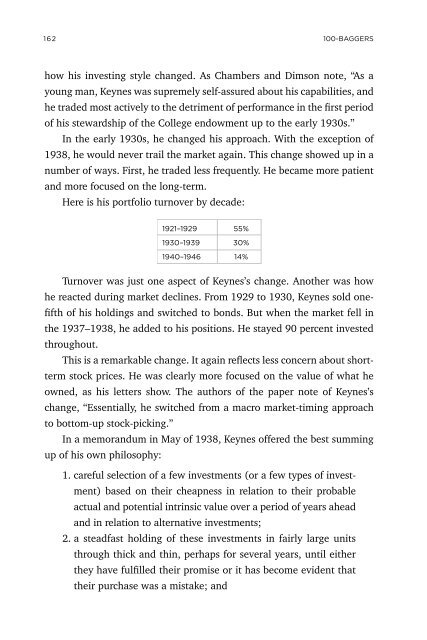You also want an ePaper? Increase the reach of your titles
YUMPU automatically turns print PDFs into web optimized ePapers that Google loves.
162<br />
100-BAGGERS<br />
how his investing style changed. As Chambers and Dimson note, “As a<br />
young man, Keynes was supremely self-assured about his capabilities, and<br />
he traded most actively to the detriment of performance in the first period<br />
of his stewardship of the College endowment up to the early 1930s.”<br />
In the early 1930s, he changed his approach. With the exception of<br />
1938, he would never trail the market again. This change showed up in a<br />
number of ways. First, he traded less frequently. He became more patient<br />
and more focused on the long-term.<br />
Here is his portfolio turnover by decade:<br />
1921–1929<br />
1930–1939<br />
1940–1946<br />
55%<br />
30%<br />
14%<br />
Turnover was just one aspect of Keynes’s change. Another was how<br />
he reacted during market declines. From 1929 to 1930, Keynes sold onefifth<br />
of his holdings and switched to bonds. But when the market fell in<br />
the 1937–1938, he added to his positions. He stayed 90 percent invested<br />
throughout.<br />
This is a remarkable change. It again reflects less concern about shortterm<br />
stock prices. He was clearly more focused on the value of what he<br />
owned, as his letters show. The authors of the paper note of Keynes’s<br />
change, “Essentially, he switched from a macro market-timing approach<br />
to bottom-up stock-picking.”<br />
In a memorandum in May of 1938, Keynes offered the best summing<br />
up of his own philosophy:<br />
1. careful selection of a few investments (or a few types of investment)<br />
based on their cheapness in relation to their probable<br />
actual and potential intrinsic value over a period of years ahead<br />
and in relation to alternative investments;<br />
2. a steadfast holding of these investments in fairly large units<br />
through thick and thin, perhaps for several years, until either<br />
they have fulfilled their promise or it has become evident that<br />
their purchase was a mistake; and


